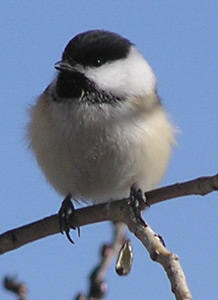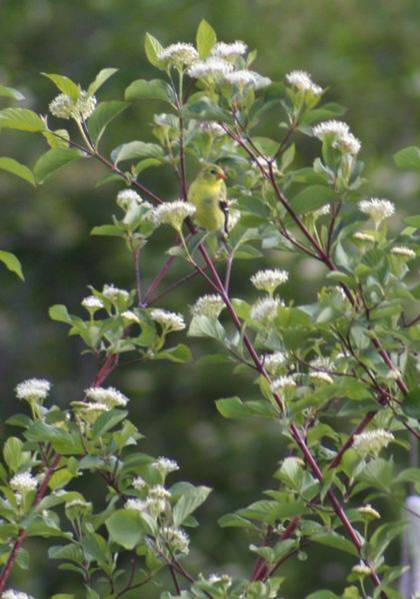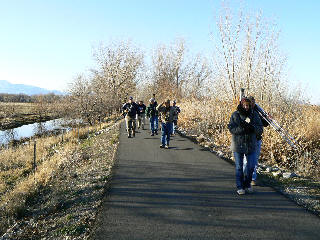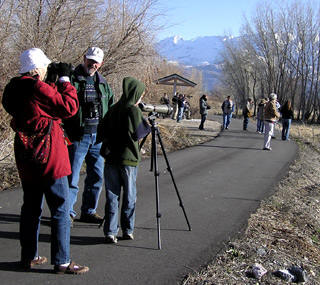Utah County Birders Newsletter
|
 |
|
Black-capped Chickadee |
Now that I have written about my favorite "Top twenty locations to go birding in
Utah" I've been thinking about the twenty most common birds I have seen in Utah.
This would be based on my birding trips over the last seven years throughout the
state, not just in Utah County, although Utah County is highly represented by
every one of the birds listed below. These are birds I have seen every
month of every year since the beginning of 2001. This information gives us a
handle on what we call "resident birds" --not those that are migratory like the
Double-crested Cormorant, Cinnamon Teal, or American Wigeon which are here
commonly during most of the year. It might be interesting for you to check your
lists and see how they compare. Before reading on, or comparing your lists with
mine, you might try predicting which twenty birds you think are the most common.
The following birds are listed in taxonomic order--not in order of abundance:
Mallard, Gadwall, Red-tailed Hawk, American Kestrel, California Quail, American
Coot, Rock Pigeon, Northern Flicker, Black-billed Magpie, Common Raven,
Black-capped Chickadee, American Robin, European Starling, Song Sparrow,
Dark-eyed Junco, Western Meadowlark, House Finch and House Sparrow.
If you took the time to count these birds you correctly noticed there were only
eighteen--not twenty. Couldn't honestly come up with twenty. But I counted six
other species that I missed seeing only one month out of the last 84 months:
Canada Gooose, Northern Harrier, Killdeer, Western Scrub-Jay, Red-winged
Blackbird and Brewer's Blackbird.
I realize where one lives
influences whether certain species are observed more than others. Also, we all
have our favorite places to check out each month (Provo airport dike, Provo
cemetery, Rock Canyon, for example), so this also biases our results. The
numbers of birding trips we make during the month (time constraints, cost of
gasoline, etc.), and also whether we maintain bird feeders during the year
influences the kind of birds we see. I know the American Dipper is a year around
resident on the Provo River not far from where I live. I just didn't make the
effort to go look for one every month even though the canyon is only five
minutes away.
It is hoped that this information will be of use to future generations of
birders. Who can predict what new bird will move in during the next decade,
especially if global warming influences a northerly movement of bird species.
Consider the Eurasian Collared Dove, for example. (I'm not using this species as
an example of global warming by the way). I didn't see it at all in 2001,
and only in three months in 2002. In 2003 I recorded it in seven months, in nine
months during 2004, eight months in 2005 and every month during the last two
years in almost every county I visited in Utah.
One can never predict what kind of changes will occur to local habitats in the
next five to ten years, or how those changes will impact the numbers of birds we
commonly see and take for granted now. The birding competition this year is
mostly based on habitats to hopefully encourage all of us to record and compile
this data for the use of future generations of birders.
 |
|
American Goldfinch at our Redtwig
Dogwood |
American Goldfinch
Carduelis tristis
Order: Passeriformes Family: Fringillidae
-Julia B. Tuck
I love the American Goldfinch! We are graced by these beauties in our yard. We
have several large Bailey Redtwig Dogwoods ( Cornus sericea Baileyii) against
the back of our brick home. We have thistle feeders on our deck. The birds love
the protection afforded them by the dogwoods as they seek refuge in them between
feedings. Sometime these birds are called “the wild canary.”
The breeding male is a brilliant, bright yellow with a black cap or forehead, and black on the wings. He has wing-bars (white or buffy colored), a white rump, white undertail coverts, black eyes and a short, forked black tail. The American Goldfinch is about 4˝-5" long (my, they look so much bigger when I look through my binoculars).
This bird breeds from southern British Columbia east to Newfoundland and south to California, Utah, southern Colorado, central Oklahoma, Arkansas, and the Carolinas. It winters throughout much of U.S. A seed eater, it prefers brushy thickets, weedy grasslands, and nearby trees. Small seeds, especially thistle, make up most of the American Goldfinch's diet. In the summer they also eat some insects, especially aphids. They feed their young entirely on partially digested seed called “canary milk.” The birds naturally feed by hanging upside down on plant stems. To encourage the American Goldfinch to come into your yard, you can plant such flowers as zinnias, cosmos, bee balm, liatris, coreopsis and globe thistle.
Some other species of the goldfinch family (Fringillidae) include the Pine Siskin, the Lesser Goldfinch, the Rosy Finch, the Crossbills, the House Finch and the Evening Grosbeak.
The American Goldfinch changes from winter plumage to breeding plumage by a complete molt of its body feathers. It is the only member of its family to have this second molt in the spring; all the other species have just one molt each year in the fall.
They nest in late June or early July. The nest is placed in a small shrub or tree, lined with plant down, and fastened to the branches with spider silk. They lay 2 to 7 eggs, pale bluish white, and are born helpless. Chicks fledge in 11-17 days. I love this: Brown-headed Cowbirds may lay an egg in a Goldfinch nest, but the hatchling will usually die because the seed-based diet of the American Goldfinch cannot support it. Way to go, American Goldfinch!
Predators of the American Goldfinch include jays, cats, hawks, snakes, squirrels, raccoons, and foxes.
A group of goldfinches can be called "a charm of goldfinches," "a rush of goldfinches," "a treasury of goldfinches," and a "vein of goldfinches."
I hope this year, as you work on the 2008 birding challenge, you will take the time to watch “a charm of goldfinches.”
 |
|
UCB on Skipper Bay Trail - 22
Mar 2008 |
 |
|
UCB on Skipper Bay Trail - 22
Mar 2008 |
Field Trip Report
Skipper Bay Trail - 22 March 2008
by Lynn Garner
Saturday morning, March 22, seventeen members and guests of the Utah County Birders walked the Skipper Bay Trail looking for birds. The amount of flooding of the pastures had diminished, but the water was not frozen as had been feared. The numbers of birds were not great, but there were many good birds to see. Perhaps the treat of the day was a flock of four Snow Geese and three Ross's Geese that we first saw at great distance, which flew much closer and allowed for sure identification. We were surprised to see no raptors at all.
The complete list of 33 species seen: Tundra Swan, Snow Goose, Ross's Goose, Canada Goose, Gadwall, American Wigeon, Mallard, Cinnamon Teal, Northern Shoveler, Northern Pintail, Green-winged Teal, Lesser Scaup, Clark's Grebe, American White Pelican, Double-crested Cormorant, Great Blue Heron, American Coot, Sandhill Crane, Killdeer, American Avocet, California Gull, Northern Flicker, Black-billed Magpie, Black-capped Chickadee, Marsh Wren, American Robin, American Pipit, Song Sparrow, White-crowned Sparrow, Dark-eyed Junco, Red-winged Blackbird, Western Meadowlark, and American Goldfinch.
Those who participated were Thaylene Barrett, Andrew Brown, Robert Brown, Kris Chandler, Susan Fales, Lynn Garner (leader), Lara Goldie, Eric Huish, Marsha McLean, Milt Moody, Carol Nelson, Richard Pace, Rod Pace, Deloy Pack, Bob Parson, Tuula Rose, Steve and Cindy Sommerfeld, and Merrill Webb.
Thoughts of a
"Greenie" Birdwatcher
by Yvonne Carter
Over the years I have had a few wake up calls to birds. I have walked through
Kensington Park in Michigan while swans sat on their huge nests just 5 to 10
feet away with either eggs to hatch or with the new fuzzy ducklings. I saw a
Bald Eagle flying through our backyard in Utah right before my eyes as I stood
on my deck. I have gazed at the birds at LaJolla Cove as I did morning walks.
All the while, I kept saying to myself that I would sure like to know more about
birds.
In early May of 2006, I saw a billboard ad for the Great Salt Lake Bird Festival
and I said to myself, "OK, Yvonne here's where you put your money where your
mouth is." I didn't know what happens at a bird festival, but I had some free
time that Saturday and walked in on a class taught by Dennis Shirley and Merrill
Webb. It was interesting and informative.
I didn’t know a thing about birding field trips, but one was planned for
Farmington Bay after the classes. They had one spot left and that was for me. No
sooner was I on the bus than other birders started rushing on with all sorts of
equipment, binoculars (I did bring a small pair with me), bird books, scopes and
notebooks in hand. As the bus entered the Farmington Bay area, someone to my
right said, "A Black-Crowned Night Heron on our right!" Gee, I thought it was
just a large bird. All heads swiftly turned to the right, and many saying "I got
it." All making notes and rapidly writing as someone else called out, "Red-wing
Blackbird at ten o'clock!" Oh, so that is what they called that blackbird with
the patch of red. Hmmm, I learned something new as they noted the spotting in
their notebooks again. On it went.
As we stopped by Egg Island, everyone moved fast to get out and take a look.
Quick as a flash the scopes were set up, their owners generously sharing the
pleasure of a closer look. My dumb question revealed that I was inexperienced.
People around me were helpful and took their time to explain differences in the
birds. By the time the field trip was over, I was hooked on birding! I excitedly
called my husband to tell him what I had learned and I quickly signed up for
another field trip, the Utah County Big Day, the following Tuesday. Then I
learned even more.
Soon after I discovered the Utah County Bird Group, and the same helpful
attitude of experienced birders. They were eager to share their knowledge, their
field guides, and equipment. They made helpful suggestions and generally made me
feel comfortable in this new activity. The monthly meetings were informative as
well and helped me to become better acquainted with members of the group.
With effort, time, and with the help of all in the group, I have become more at
ease in identifying birds, comfortable in using equipment I have since acquired.
So let me express my appreciation to each of you who have been willing to share
your expertise, knowledge and understanding of birds, and patiently enduring my
silly questions. I enjoy being a part of the birding family in search for that
elusive bird.
HELP - I DO NOT KNOW THE
ANSWER !!
by Ned Bixler
We go through life thinking ALL questions have an answer. Then we become
birders. We start a list, and find new birds. This seems easy.
Then, it happens at which bird am I looking A or B ?? We think this is a simple
problem to solve, just ask the "BIRDING EXPERTS". They will know the answer.
Then we are shocked. We find they also may disagree about which bird it is!
Several years ago, an immature swan was seen for months in a pond at Salem. The
birding world argued whether it was a trumpeter or a tundra swan. When they
finished, it was 50% for a trumpeter swan, and 50% for a tundra swan. So
which was it?
Last year, a Jaeger was seen at Farmington Bay. The same scenario - Pomarine or
Parasitic. The same results were 50% each among the birding world.
Year, 2008, is no different. Immature swans have been seen on the Burriston
Ponds, and they are falling into the same pattern as previously mentioned: 50%
say trumpeter, and 50% say tundra.
Today it is the red-shouldered hawk at Farmington Bay, and the cackling goose at
Kaysville Pond. The list goes on and on.....
Will the day come when we have a pocket DNA kit, and solve all these arguments
in the field ? Probably not.
Do we give up birding because we cannot agree? NO - keep studying, and trying to
learn more about the bird. Then you make YOUR decisions.
In birding, there will always be birds on which we will not agree.
Good Birding.
Backyard Bird of the
Month
March 2008
Steve Carr - Holladay
Brown Creeper - Fourth year of the last 5 years; yet only the 5th year of
the last 38 at our home in Holladay.
Yvonne Carter - Highland
I set out a woodpecker brick Friday (3/28) and Sat. my first Hairy Woodpecker
showed up.
KC Childs - Eugene, Oregon
My best backyard bird here in Eugene was a Bushtit, I live on a busy
road, so the birds seem to avoid the area a bit.
Lynn Garner - Provo
A Downy Woodpecker inspecting every inch of our sumac tree.
Alona Huffaker - Springville
My favorite is the Western Screech-Owl I could hear from my yard that was
in my backyard neighbors' yard for a few nights. She had called and explained
the sound she had heard and we finally figured out what it was that she had
heard, so when she heard it again, she called me. Big sound for a little bird!
Eric Huish - Pleasant Grove
Eurasian Collared-Dove - March 1st (finally on my yard list, # 91)
Selena & Alan Keller - Orem
Eurasian Collared-Dove - A pair, out where my flowers are coming up.
Milt Moody - Provo
Western Screech-Owl & White-breasted Nuthatch - Hermit Thrush
still here.
Carol Nelson - Provo
Happy to have my first Pine Siskin of the year. I was afraid a Starling
was going to get the honor.
Cheryl Peterson - Provo
Red-breasted Nuthatch
Tuula Rose - Provo
My regular pair of Mourning Doves was joined by a whole flock one day. I
counted a dozen. They cleaned out the leftover big milo seed no other bird will
eat.
Margaret Sanchez - Provo
Cedar Waxwings - Small flock feeding in my crabapple. Also a flock of Juncos.
Cedar Waxwings are my favorite bird and these were the first I've seen this
year.
Dennis Shirley - From Tokyo, Japan
One morning in my daughter's neighborhood - Jungle Crow, Tree Sparrow,
Brown-eared Bulbul, Pygmy Woodpecker, Pale Thrush, Great
Tit.
Reed Stone - Provo
A Cock Ring-necked Pheasant feeding on grass and seeds.
Alton Thygerson - Provo
Downy Woodpecker - two have been coming to a suet feeder but they also
have been seen feeding on shelled black oil sunflower kernels out of a tube
feeder.
Bonnie Williams - Mapleton
Yellow-rumped Warbler
We would like you to share your favorite backyard bird each month. Please send
your favorite bird at the end of the month to newsletter@utahbirds.org or call
360-8777.
DUES
For you faithful members who have always paid dues, but haven't as yet made the
leap this year, the doors to the treasury are still open. For
any wannabe members, they are also open. 2008 dues are $15.00.
Make a check to Utah
County Birders and mail it to:
Carol Nelson
2831 Marrcrest West
Provo, Utah 84604